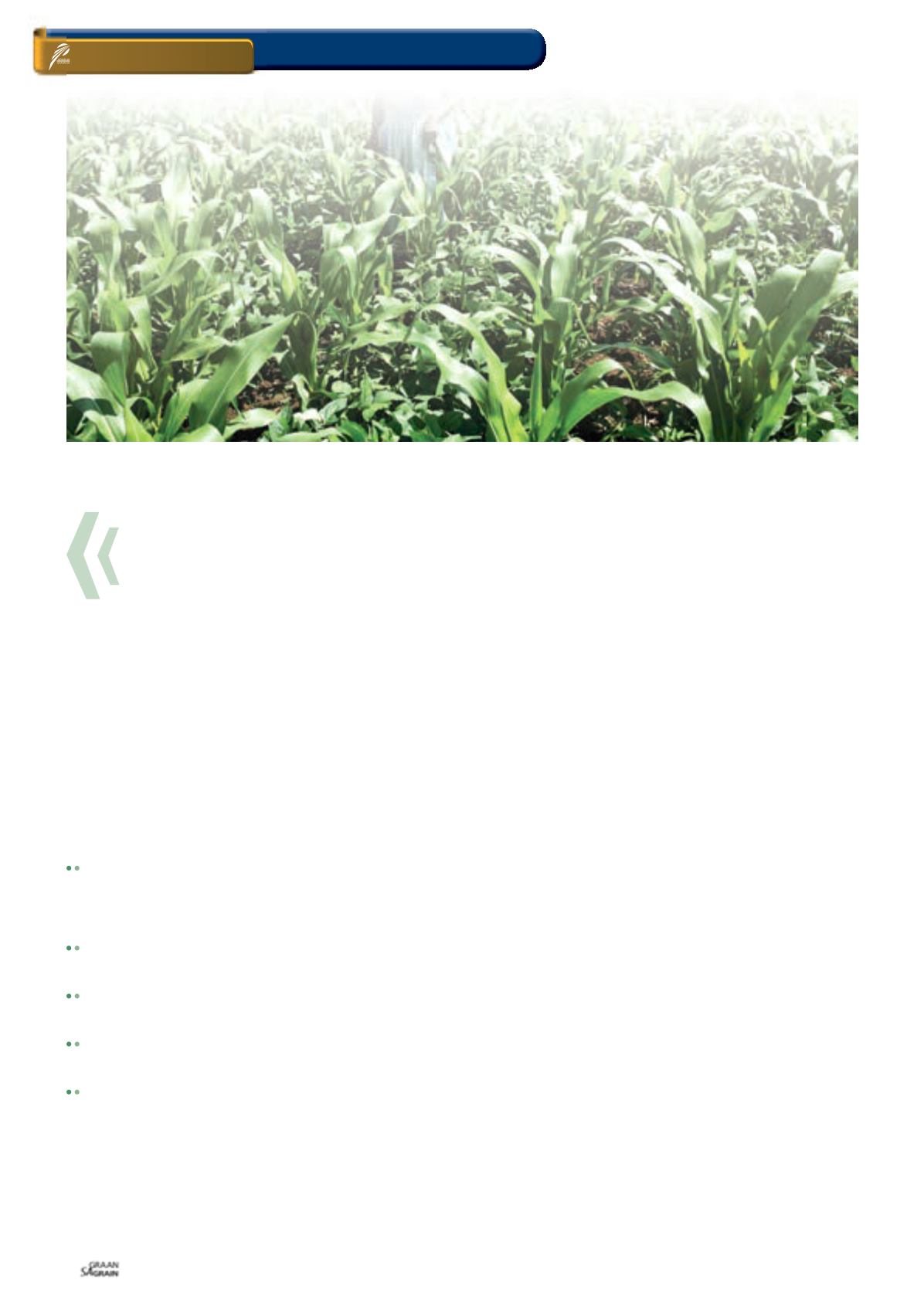
September 2014
110
ON FARM LEVEL
Conservationagriculture
The CA practices introduced to them comprised planting without
ploughing using specialised hand planters, retaining the crop
residues on the soil surface and crop diversity, i.e. intercropping
with legumes and crop rotationswithwinter livestock foddermixes.
A high crop density approach (i.e. narrow rows and higher plant
populations) was followed to reduce soil water loss from evapora-
tion and to suppress weed growth, whilst accelerating soil health
improvement.
The volunteering “CA groups” joined in an ongoing learning pro-
cess throughout the season using their trials as “field laboratories”
and their groupmeetings as social learning events.
31 farmer-led trials have been conducted in the Bergville area
between October 2013 and April 2014 as part of the smallholder
CA FIP project (see
Photo 1
). These farmers are also members of
CIGs, all of whom participated in the learning processes. Around
120 farmers havebeen involved.
Participants in thisproject’s innovationprocess have recognised the
followingoutcomes andbenefits:
Theyhaveexperimentedwithnewwaysof field cropproduction
(maize, dry beans and cowpeas) that have shown good growth,
increased yields, increased soil fertility, reduced soil and water
erosion, reduced weed pressure and increased income from
sellingmaize andbeans.
They have learnt about soil management and how to use and
apply agricultural inputs, such as fertiliser, pesticides and
herbicides.
They have worked together as teams to plant their plots, which
have helped considerably to prepare the fields in time and
reduce theburdenof labour.
They have spread theword toothermembers in the community
and have generated a positive force towards working together
and increasingproduction in their areas.
They have undertaken to increase their planting areas as well
as the use of CA, since the benefits from this season have been
obvious: Savingmoney on the hiring of tractors, saving labour
after the initial planting process, less infestation of weeds,
increasedproduction and improved food security.
Yields for legumes have been exceptionally good and comparable
to commercial yields, notwithstanding late season hail and rain
that destroyed some of the crop. Average yields for beans have
been from 720 kg/ha - 1,8 ton/ha and for cowpeas from 400 kg/ha -
1,2 ton/ha. Maize yields thus far have been equally good averaging
around 4,2 ton/ha.
Considerable interest was generated through the FIP process of
farmer-led trials in CA at the Bergville communities of Potshini,
Emmaus and Stulwane. Farmer days were held in each of the three
areas towards the end of the growing season to showcase thework
being done. These were well attended by local people and stake-
holders alike. Themain farmers daywas held on 25March this year
(see
Photos 2a
to 2c
). People within the area and from neighbour-
ing areas have taken proactive steps towards being included in
the process in the coming year and four new CIG focus groups
will be established in the communities of Magangangozi, Ezivom-
bini, Okhombe andNokophela.
Bergville farmers gainingmomentum
Groups have now been set up to facilitate bulk buying in both
Emmaus and Stulwane and SCG members have planned their
savings in order to buy inputs for field cropping. In addition, a pro-
cess for the borrowing and hiring of CA equipment for the broader
community has been initiated in Stulwane and Emmaus. Positive
links were formed in the local agribusiness community, including
joining study groups set up through Grain SA, forming relation-
ships with Afritrac for supply of CA implements, forming
relationships with the KwaZulu-Natal Department of Agriculture
and Environmental Affairs (DAEA) and the Farming Systems Unit
for promotion of CA in the area, as well as with the University of
KwaZulu-Natal (UKZN) to conduct research regarding the adoption
and adaptationof CA in the area.
Over the next two years, the processwill be scaled out in the Berg-
ville area and surrounds, linking asmany villages and communities
as possible and working according to a model whereby more
experienced farmers will each facilitate and assist five new farmers
to establishCApractices in their fields.
In this way, approximately 1 000 smallholders could be on board
within the next few years. In the long term, the vision is to establish
an incentive scheme, such as payment for ecosystem services,
to sustain and grow farmers’ adoption of CA without relying on
continueddedicatedproject funding.
The CA-FIP project platforms among smallholders in Bergville
are already gearing up to meet these challenges with the view of
sustainable cropproduction andhousehold food security.
CA boosts smallholder crop production in KwaZulu-Natal


